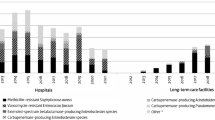Abstract
The increasing incidence of ESBL-producing Enterobacteriaceae (ESBL-E) in France prompted the publication of national recommendations in 2010. Based on these, we developed a toolkit and a warning system to optimise management of ESBL-E infected or colonised patients in both community and hospital settings. The impact of this initiative on quality of care was assessed in a teaching hospital. The ESBL toolkit was developed in 2011 during multidisciplinary meetings involving a regional network of hospital, private clinic and laboratory staff in Southeastern France. It includes antibiotic treatment protocols, a check list, mail templates and a patient information sheet focusing on infection control. Upon identification of ESBL-E, the warning system involves alerting the attending physician and the infectious disease (ID) advisor, with immediate, advice-based implementation of the toolkit. The procedure and toolkit were tested in our teaching hospital. Patient management was compared before and after implementation of the toolkit over two 3-month periods (July–October 2010 and 2012). Implementation of the ESBL-E warning system and ESBL-E toolkit was tested for 87 patients in 2010 and 92 patients in 2012, resulting in improved patient management: expert advice sought and followed (16 vs 97%), information provided to the patient’s general practitioner (18 vs 63%) and coding of the condition in the patient’s medical file (17 vs 59%), respectively. Our multidisciplinary strategy improved quality of care for in-patients infected or colonised with ESBL-E, increasing compliance with national recommendations.
Similar content being viewed by others
References
Birgand G, Johansson A, Szilagyi E, Lucet JC (2015) Overcoming the obstacles of implementing infection prevention and control guidelines. Clin Microbiol Infect. https://doi.org/10.1016/j.cmi2015.09.005
Point prevalence survey of health care associated infections and antimicrobial use 2011-2012: http://ecdc.europa.eu/en/publications/Publications/healthcare-associated-infections-antimicrobial-use-PPS.pdf
Zahar JR, Lesprit P, Ruckly S, Eden A, Hikombo H, Bernard L, Harbarth S, Timsit JF, Brun-Buisson C (2017) BacterCom Study Group. Predominance of healthcare-associated cases among episodes of community-onset bacteraemia due to extended-spectrum β-lactamase-producing Enterobacteriaceae. Int J Antimicrob Agents 49(1):67–73. https://doi.org/10.1016/j.ijantimicag.2016.09.032
Löhr IH, Rettedal S, Natås OB, Naseer U, Oymar K, Sundsfjord A (2013) Long-term faecal carriage in infants and intra-household transmission of CTX-M-15-producing Klebsiella pneumoniae following a nosocomial outbreak. J Antimicrob Chemother 68(5):1043–1048. https://doi.org/10.1093/jac/dks502
Nielsen MV, Sarpong N, Krumkamp R, Dekker D, Loag W, Amemasor S, Agyekum A, Marks F, Huenger F, Krefis AC, Hagen RM, Adu-Sarkodie Y, May J, Schwarz NG (2012) Incidence and characteristics of bacteremia among children in rural Ghana. PLoS One 7(9):e44063. https://doi.org/10.1371/journal.pone.0044063
Ma X, Wu Y, Li L, Xu Q, Hu B, Ni Y, Wu A, Sun S, Jarlier V, Robert J (2015) First multicenter study on multidrug resistant bacteria carriage in Chinese ICUs. BMC Infect Dis 15:358. https://doi.org/10.1186/s12879-015-1105-7.
Cholley P, Thouverez M, Gbaguidi-Haore H, Sauget M, Slekovec C, Bertrand X, Talon D, Hocquet D (2013) Hospital cross-transmission of extended-spectrum β-lactamase producing Escherichia coli and. Med Mal Infect 43(8):331–336. https://doi.org/10.1016/j.medmal.2013.06.001
Ho C, Lau A, Cimon K, Farrah K, Gardam M (2012) Screening, isolation, and decolonization strategies for vancomycin-resistant enterococci or extended spectrum beta-lactamase producing organisms: a systematic review of the clinical evidence and health services impact [Internet]. Canadian Agency for Drugs and Technologies in Health, Ottawa (ON) CADTH Rapid Response Reports
Le Coz P, Carlet J, Roblot F, Pulcini C (2016) Human resources needed to perform antimicrobial stewardship teams’ activities in French hospitals. Med Mal Infect 46(4):200–206. https://doi.org/10.1016/j.medmal.2016.02.007
Arnaud I, Maugat S, Jarlier V, Astagneau P (2015) National Early Warning; Investigation and Surveillance of Healthcare-Associated Infections Network (RAISIN)/multidrug resistance study group. Ongoing increasing temporal and geographical trends of the incidence of extended-spectrum beta-lactamase-producing Enterobacteriaceae infections in France, 2009 to 2013. Euro Surveill 20(36). https://doi.org/10.2807/1560-7917.ES.2015.20.36.30014.
De Angelis G, Cataldo MA, De Waure C, Venturiello S, La Torre G, Cauda R, Carmeli Y, Tacconelli E (2014) Infection control and prevention measures to reduce the spread of vancomycin-resistant enterococci in hospitalized patients: a systematic review and meta-analysis. J Antimicrob Chemother 69(5):1185–1192. https://doi.org/10.1093/jac/dkt525
Kac G, Grohs P, Durieux P, Trinquart L, Gueneret M, Rodi A, Boiron P, Guillemain R, Leglise J, Meyer G (2007) Impact of electronic alerts on isolation precautions for patients with multidrug-resistant bacteria. Arch Intern Med 167(19):2086–2090
Maslikowska JA, Walker SA, Mittmann N, Palmay L, Daneman N, Simor A (2016) Impact of infection with extended-spectrum β-lactamase-producing Escherichia coli or Klebsiella species on outcome and hospitalization costs. J Hosp Infect 92(1):33–41. https://doi.org/10.1016/j.jhin.2015.10.001
Wiklund S, Hallberg U, Kahlmeter G, Tammelin A (2013) Living with extended-spectrum β-lactamase: a qualitative study of patient experiences. Am J Infect Control 41(8):723–727. https://doi.org/10.1016/j.ajic.2012.10.009
Acknowledgements
We thank Brigitte Dunais for her assistance in preparing this manuscript.
Author information
Authors and Affiliations
Corresponding author
Rights and permissions
About this article
Cite this article
Mondain, V., Lieutier, F., Pulcini, C. et al. Improved quality of care for patients infected or colonised with ESBL-producing Enterobacteriaceae in a French teaching hospital: impact of an interventional prospective study and development of specific tools. Eur J Clin Microbiol Infect Dis 37, 977–981 (2018). https://doi.org/10.1007/s10096-018-3234-6
Received:
Accepted:
Published:
Issue Date:
DOI: https://doi.org/10.1007/s10096-018-3234-6




